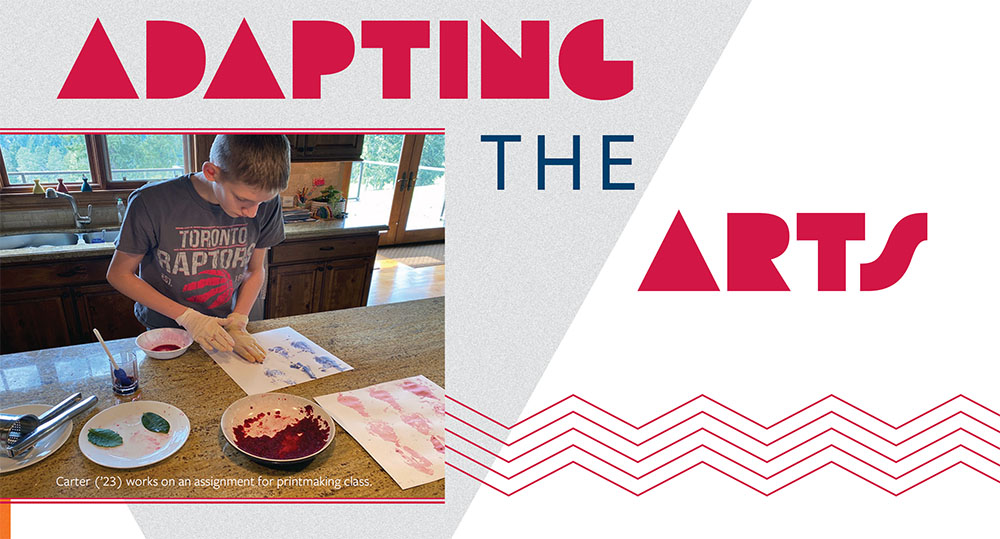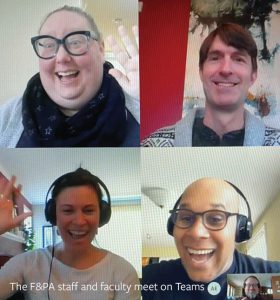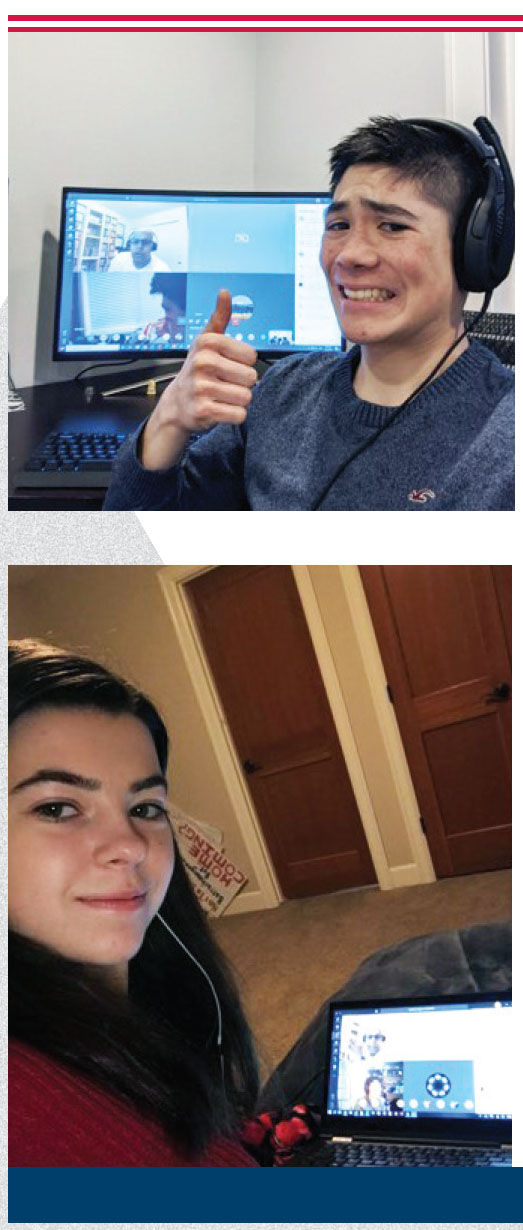
By Ginger Ellingson, Director of Fine and Performing Arts
 WITH THE GOAL OF UNIFYING OUR program and providing a shared academic experience, the Fine and Performing Arts use specific language to describe the artistic process across our multiple specialties. In each art class, we Respond to the world around us and to the feedback from our audiences; Connect with ourselves, our community, and our world; Create and recreate artwork; and Perform & Present to the community. Although much changed in the spring of 2020, the vision for our classes remained defined by the same artistic process that has always shaped our work.
WITH THE GOAL OF UNIFYING OUR program and providing a shared academic experience, the Fine and Performing Arts use specific language to describe the artistic process across our multiple specialties. In each art class, we Respond to the world around us and to the feedback from our audiences; Connect with ourselves, our community, and our world; Create and recreate artwork; and Perform & Present to the community. Although much changed in the spring of 2020, the vision for our classes remained defined by the same artistic process that has always shaped our work.
An essential expression of the human experience, art always finds a way to adapt and respond. As opera singers turned balconies into stages in quarantined Italy and street artists turned boarded-up storefronts into murals across our cities, the arts faculty was also determined to respond to the new constraints of remote instruction. In his Intro to Band class, Dr. Ed Castro quickly learned that some parts of class could continue as normal while other parts would change significantly. Breathing exercises and stretches, for instance, were easily communicated through digital systems and visual aids. But playing instruments together in real time simply was not possible. Nonetheless, Castro responded to this newfound reality and was able to support his students in instrumental development by providing feedback on students’ video recordings. “Students and I have access to an interactive classroom, and a digital audio workstation, where students can record themselves playing exercises and send it directly to me.” Dr. Castro found his students gained a lot through the process of recording and critically listening to themselves, so much so that he plans to continue this teaching practice even when live performances are possible again.
AN ESSENTIAL EXPRESSION OF THE HUMAN EXPERIENCE, ART ALWAYS FINDS A WAY TO ADAPT AND RESPOND.
Opportunities for connection to the world beyond the computer were also embraced in the Fine and Performing Arts classes. Students’ practice time in music classes and working with their hands in visual art classes provided alternative modes of learning, a respite from screen time, and challenged students to find new tools around them. While supply kits were in transit to Amis Balcomb’s art classes, students creatively used materials found in their homes. “The paper and glue mask persona project was a complete success. It was so simple in the materials used, but required finesse.”
In Stagecraft, which typically uses equipment in the set shop, Rick MacKenzie was still able to achieve his goal for students “to physically work on projects that have a large number of parameters but still feel artistic and personal.” For one project, students relied on household tools and materials to build puppets that were modeled after an Indonesian shadow puppet style students studied in the history portion of class. MacKenzie remarked, “I was impressed by the amount of investment they would put into each project. I hoped they would view my class as a break from screen time. I think most of them did.”
“WE WILL CONTINUE TO USE THE SKILLS WE PICKED UP IN OUR REMOTE EXPERIENCES TO EXPAND THE WAYS WE LEARN AND CREATE ART. THROUGH THESE EXPERIENCES, WE ALL CAME OUT THE OTHER END WITH SHARPER TOOLS AND WIDER FIELDS OF VISION TOWARD EDUCATION.”

Top: Ethan (’21) participates in an EPSRemote class. Bottom: Kalie (’22) participates in an online class.
As students attended class from various bedrooms, offices, and kitchen tables across the greater Kirkland area, other art classes also connected with the current realities of the world. After reading excerpts from Ross Gay’s The Book of Delights, Brian Hutcheson’s Printmaking class kept gratitude journals and created prints inspired by their writing. In his seminar with David Fierce on Contemporary Art and Social Justice, students chose topics such as social distancing in refugee communities. In my own Chamber Choir class, students made parody music videos of quarantine and online learning, and recorded a virtual choir about changing the world for the better. Alek Edmonds’ Digital Filmmaking class produced Microsoft Teams commercials, and he remarked that “the students work was on par with other commercials that Microsoft created to highlight the functionality of Teams. I was really proud of their hard work.”
Drama classes were particularly challenging without in-person rehearsals and performances. However, as Ian Duncan writes, a return to the basic principle of play and the artistic process of creating yielded a learning experience for everyone involved. “Canceling the musical and moving our theatre community online was extremely difficult to say the least. None of us knew how we would make such an endeavor work. It was through play that we found our path. The idea of play in our lives has perhaps never been as important as it is right now, and for student and teacher alike, the process of putting together the Spring Showcases allowed us to return to the proverbial drawing board and turn the work of theatre back into the play of theatre.” Duncan commented that it was his “hope that the 2020-2021 school year will afford us all the opportunity to keep playing as we learn and grow.”
As Duncan points out, it would be untruthful to say we went about reconstructing our spring 2020 classes without significant mourning of the traditional end-of-year experiences. However, performing and presenting are essential to our process, so of course, the show must go on. Made possible by Edmonds and his film production students, the online Upper and Middle School Art Showcases captured students’ work on the after-school spring theatre and music production. Unlike a typical performance where the audience applauds and cheers at appropriate times, impressive examples of love and community were found in the chat window in real-time reactions. GIFs, emojis, likes, and comments uplifted the students as the audience viewed previously recorded set designs, monologues, scenes, and songs. More than seventy computers logged in to each event, as parents, faculty, and students joined in celebrating the work of the EPS arts community. Did we miss the traditional spring arts celebrations? Of course. However, we were successful in creating an artistic event together, celebrating each student’s work, and reminding each of us of the rich and vibrant community to which we belong.
Reflecting on the Fine and Performing Arts experience this past spring, Castro said it well: “We will continue to use the skills we picked up in our remote experiences to expand the ways we learn and create art. Through these experiences, we all came out the other end with sharper tools and wider fields of vision toward education.” Or, as Lisa Frystak, incoming Middle School drama faculty, summed it up, “Art can be made anywhere.”

